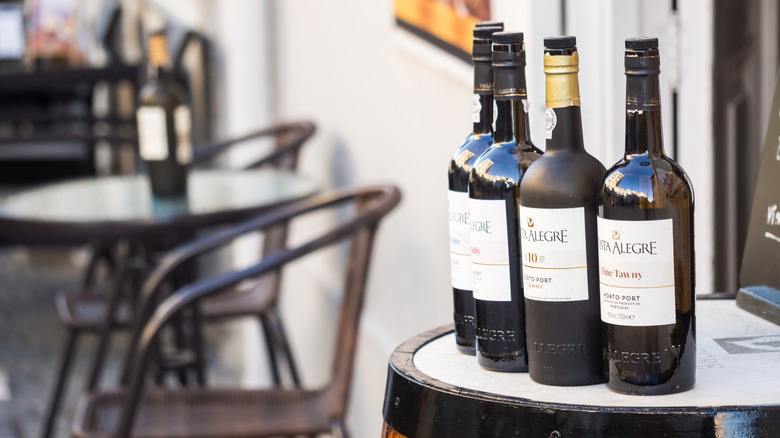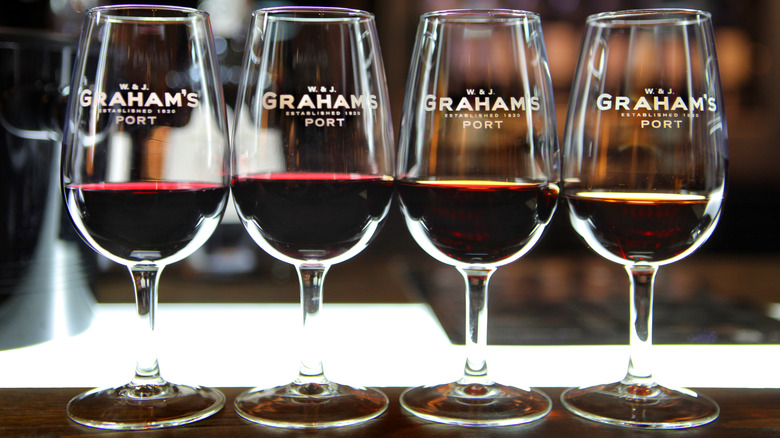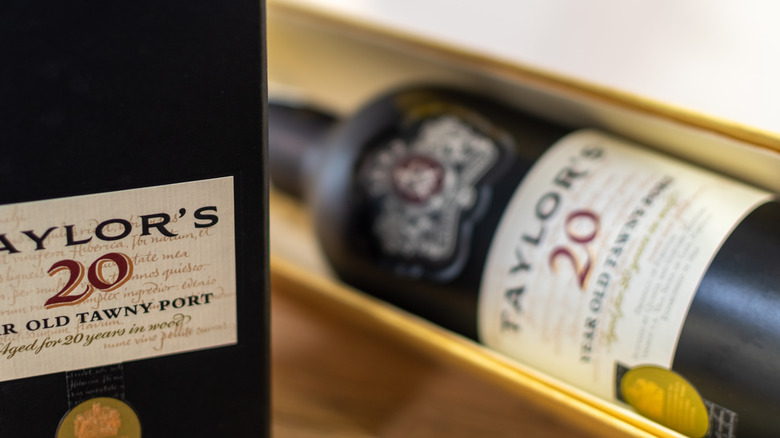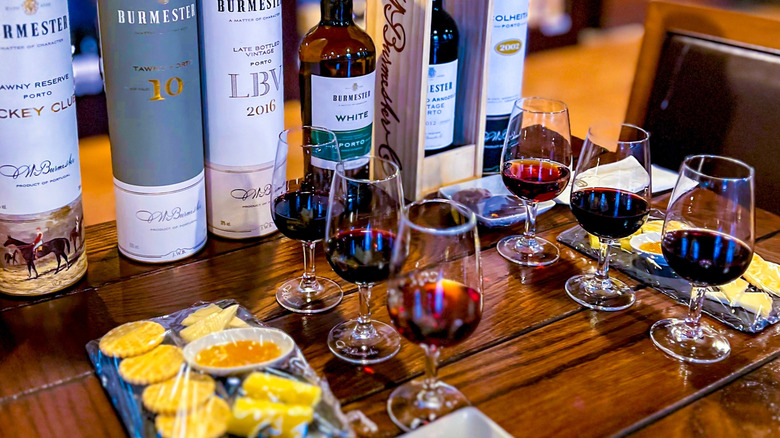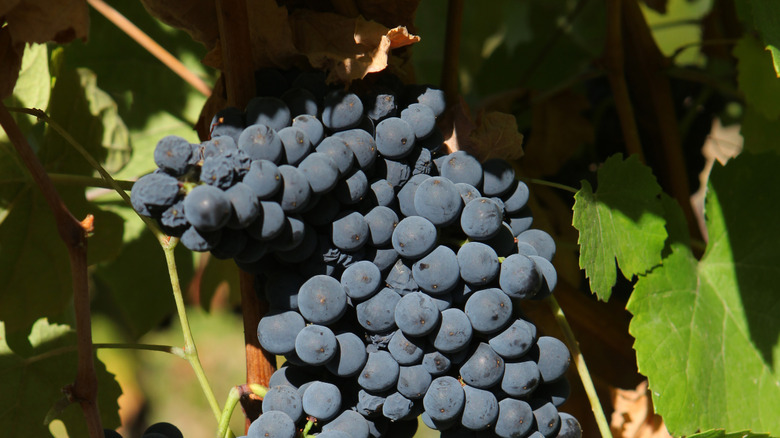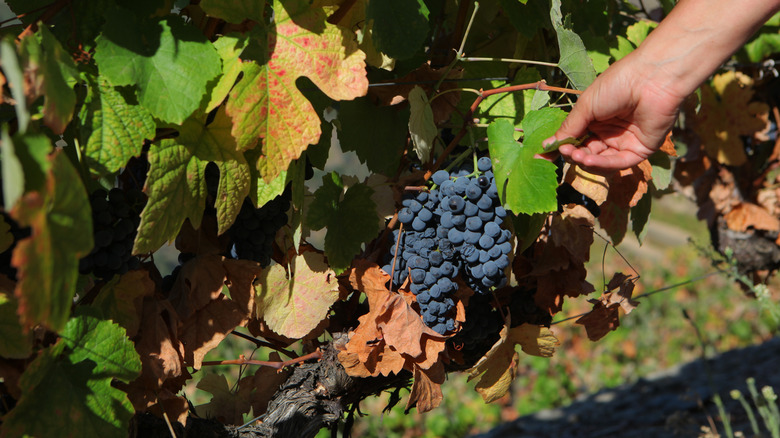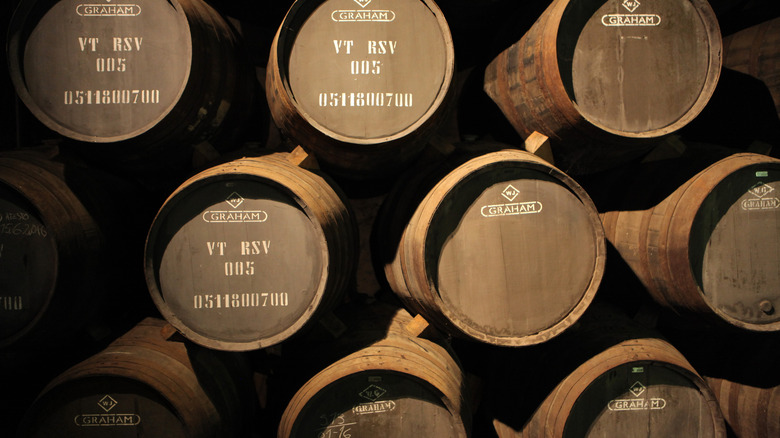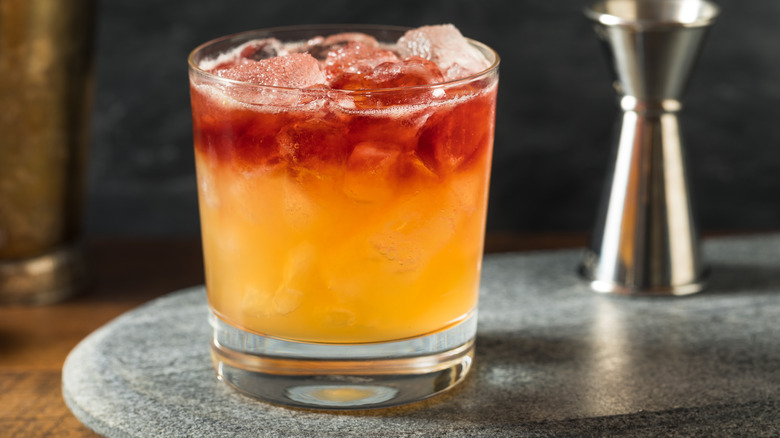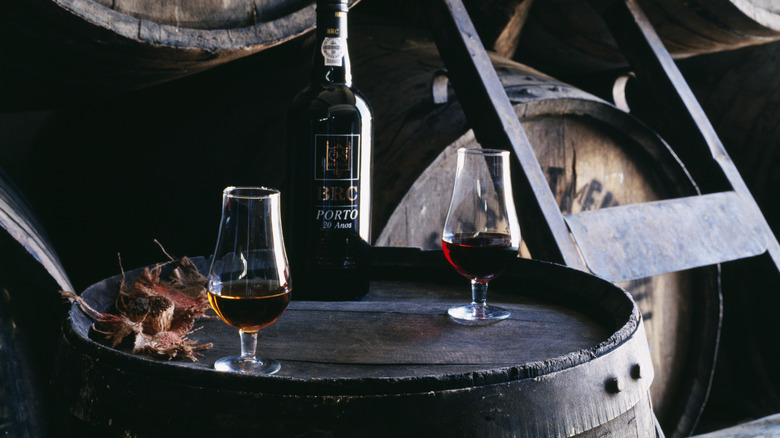What Makes Port Wine Unique, And When You Should Drink It
Port has a history as rich as the drink itself. The Romans first sowed the seeds of port production when they started cultivating grapes in what is now Portugal's Douro Valley, the home of the world's port industry, back in 200 BC. But it wasn't until the 1600s (with the help of the English, as you'll learn below) that port really started to take off in popularity — specifically with the richest, most elite members of society.
Now, port is still drunk all over the world. But the market for the sweet, fortified wine is evolving. While it has long been thought of as an old person's drink (similar to other fortified wines, like sherry, for example), research suggests more young people are starting to love it, too.
For example, in 2020, seventh-generation port maker George Sandeman told Forbes that more young American women were starting to enjoy port. He noted that this could be, at least in part, because it works as a base for many different cocktails. He explained that port brings "fruit and nutty flavors" to drinks, as well as "hint of sweetness."
Port's ability to help form a good cocktail is just one of the unique benefits of the drink. Keep reading to find out about the drink's potential to transform desserts, how it's produced, its fascinating history, when to drink it, and more.
Port is a key part of English, French, and Portuguese history
In Georgian England, while the poorer members of society were drinking beer and spirits, the elite were drinking port religiously. William Pitt the Younger, who served as England's prime minister from 1783 to 1801, once claimed he could drink three bottles of port and still feel fine the next morning. This didn't work out too well for him in the end, as he died from alcoholism at the age of 46.
But Pitt wasn't alone. The richest members of English society could not get enough of port, which was imported to the country from Portugal. Even the King at the time, George III, had a cellar stocked with port. In fact, after it was first purchased for the royal court in 1762, the fortified wine quickly became the most popular wine in the household.
But port wasn't always the drink of choice. The rich members of English and British society used to savor wine from France, but conflict in the country put a stop to trade at the beginning of the 18th century, so Brits were forced to look elsewhere for their favorite alcoholic tipple. The Portuguese happily obliged with their signature red wine: Port produced in the Douro Valley, near the city of Porto. Port is still popular in the U.K. today, and the country remains one of the top markets for port in the world, alongside countries like the U.S. and France.
The port we know today was invented by accident
Port is now known for its signature sweet taste, but prior to the early 18th century, the wine was actually more dry and tannic. This was due to the amount of tannins in the drink, which contribute to dryness and come from elements of wine production like the wooden barrels and the grape's skin, pip, and stems.
Port changed when the English decided to start importing the drink to their shores. To get the wine across the sea from Portugal without spoiling, brandy was added to the mix. This not only increased the alcohol content of the drink, which would help it last the long journey over the high seas, but it also interfered with fermentation. This resulted in the wine's higher sugar content and a drink that had a much sweeter taste than before.
The English loved the sweet taste of port with brandy, and so did everyone else. Today, brandy is still used in the production of port, although it is now added during fermentation rather than after. This results in a rich, sweet wine that is commonly enjoyed with other sweet foods, like ice cream and chocolate. Port is often also paired with strong cheese, as the sweetness complements salty, savory flavors.
Port is more alcoholic than most other wines
Port wine is not just sweet, it's also more alcoholic than many other wines. On average, most wines have an alcohol content of around 12%. Red wines tend to be a little stronger than other varieties, and can often land at around 13.5%.
Port, however, ranges from around 16% to 20%. Tawny varieties tend to be at the lower end, while vintage port is usually at the higher end. The key reason port is more alcoholic than other wines is because it is fortified with brandy during the fermentation process.
Brandy, a type of distilled wine, is even more alcoholic than port in its original form. In fact, some bottles can have an alcohol content of 60%. Strength wise, this puts it in line with spirits like vodka, gin, and rum. Other strong types of fermented wine, similar to port, include sherry, vermouth, and marsala.
Port wine is always made with Portuguese grapes
There are several different types of port. Ruby and tawny are the most common — both boast a sweet fruity flavor, but ruby (as the name suggests) is more red in color, while tawny is more amber. Tawny, which is often aged, has more notes of caramel, while ruby has a deeper chocolate flavor profile. As well as ruby and tawny, there is also rosé port (which was invented far more recently, in 2008) and white port. The latter is similar to red and amber port, but it's made with white grapes.
Each type of port is slightly different in color and flavor, but all have one key thing in common: They are all made with indigenous Portuguese grapes. All of the grapes used in the production of port are still grown in the Douro Valley, just as they were in the 18th century. The most common types of grapes used in port production are varieties like Touriga Nacional, Touriga Francesa, Tinta Roriz, Tinta Barroca, and Tinta Cão.
True port can only be made with grapes grown in Portugal. This is because the drink is covered under the European Union's Protected Designation of Origin. Similar drinks can be produced outside of Portugal, but they are often labeled as port-style rather than port.
Grapes for port are often picked by hand
Around the world, roughly 10,000 varieties of grape are grown for the wine industry across millions of hectares of land. Fun fact: It takes around 600 to 800 grapes to make one standard 750-milliliter bottle of wine. While many of those grapes will be picked with the help of mechanical harvesters, some winemakers still rely on the traditional method of handpicking. And this is the case with many of Portugal's port producers.
There are a few advantages to picking grapes by hand. For example, while a machine cannot tell the difference between a good grape and a spoiled grape, a person can individually select only the best-looking, ripest grapes for harvest. Picking by hand also reduces the chance of damaging the grapes during the harvesting process, as machines are much rougher than human fingers. While it has many benefits, hand-picking is not an easy choice. It is more costly than using mechanical methods, due to the amount of humans who must be paid and fed during the harvesting process.
After the grapes are harvested by hand, sometimes, they are crushed by foot. However, machines are often used in addition to manpower at this part of the process. Crushing grapes by foot is one of the oldest ways to prepare them for winemaking. It is still used today because it is an effective way of carefully breaking grape skins without damaging the seeds.
Porto, Portugal is one of the best places in the world to taste port
It makes sense that as port is made in Portugal, the best place to try port is also in Portugal. Porto is a large coastal city in the northwest of the country, and due to its proximity to the Douro Valley (it's about a 90 minute drive), it's a great place to enjoy port tasting.
Porto is home to many historic port wine cellars, most of which are located in the nearby city of Vila Nova de Gaia. The city lies in the district of Porto, and is often considered part of the city of Porto because of its role in the city's tourist trade. In Vila Nova de Gaia, you'll find Casa Kopke, for example, which is the oldest port house in Portugal. It was first founded in 1638 by Nicolau and Cristiano Kopke, and it is still run by the same family, generations later.
Other popular historic port houses in Vila Nova de Gaia include Cockburn's Port, which was founded in 1815 by Scottish brothers Robert and John Cockburn. Today, you can visit Cockburn's for a tour of the cellar and a port tasting. You can also head to Graham's Port Lodge, which was founded in 1820, and currently offers guided tours, tasting, and dinner at its on-site restaurant. Taylor's Port Wine, which is one of the region's biggest port houses and was founded in 1692, is also located in Vila Nova de Gaia.
Old port barrels are sometimes used by the whiskey industry
Of course, the port industry already has a relationship with the brandy industry. After all, brandy is an integral part of the port-making process. But this sweet, fortified Portuguese wine also plays a role in the whiskey industry, too.
This is because, after the British started enjoying port frequently, the U.K. found itself with many spare port casks. Instead of disposing of the empty casks, which were usually made with oak, the Brits decided to make some money by selling them to the whiskey industry. Whiskey producers then used the barrels to age their product. But it wasn't just a case of recycling. The old port barrels would also help to infuse sweet fruity flavors into the drink, and sometimes change the color of the whiskey, too.
Port isn't alone. Old barrels used in the production of sherry (another fortified wine, this time from Spain) are also used in the whiskey industry for the same reason. The collaboration between the port, sherry, and whiskey industries demonstrates a sustainable use of resources — barrels can be reused multiple times before they are disposed of.
You can make a variety of cocktails with port wine
Port is often drunk as it comes, with no mixer. After you've opened a bottle, most will last you several months in the fridge, so there's no rush to drink it down fast (unless you've purchased a vintage port, which will only last a few days). But port also works in many different cocktail recipes, too. As mentioned above, this is becoming an increasingly popular way to enjoy port, particularly with young people.
Wine cocktails, particularly red wine cocktails, aren't as common as spirit cocktails. Perhaps the most popular and well-known red wine cocktail is sangria, for example, which is a Spanish cocktail usually made with a mix of wine and fruit. But there are many cocktail recipes that work well with red wine, as well as fortified wines like port.
Port lemonade, for example, is a mix of port, vodka, lemonade, and ice. The Suburban (a cocktail that originated in New York) also combines tawny port with rum, whiskey, and bitters. The Bar Drake Manhattan, which originated in the Sir Francis Drake Hotel in San Francisco, is also a mix of port, bourbon, maple syrup, and angostura bitter.
You can also swap port into familiar favorites. A Portojito, for example, is a twist on the traditional mint mojito but made with white port. A Port of Margarita is similar to a traditional Margarita, only alongside tequila and lime, it's made with ruby port.
Port can be used to add extra sweetness to desserts
Port can be used in many different recipes. Not just cocktails, but desserts, too. For example, port wine cake is a Portuguese dessert made with port (of course) as well as other common cake ingredients, like eggs, flour, and butter.
Port can also be added to many different cake recipes, including fruit cake and chocolate cake, as it helps to provide sweetness, as well as a rich depth of flavor to the dessert. Beyond cake, port can also be used to make chocolate fondue, poached pears, and chocolate torte.
The fortified wine can even be used in ice cream recipes, as it helps to sweeten the frozen dessert, as well as keep the texture soft and velvety. Port is also a good choice of liquor for boozy affogato, a traditional Italian dessert that combines alcohol with vanilla ice cream and espresso.
Port is a dessert wine, but you can also drink it as an aperitif
Sometimes, a glass of port by itself is the dessert. This fortified wine is technically a dessert wine, which makes sense, considering how sweet it is. However, while it is an enjoyable after-dinner treat for many, port doesn't have to be drunk at the end of the meal.
Port is usually a digestif, which means it is drunk after a big meal to help with digestion, but it's also a good choice of aperitif. Traditionally served cold, aperitifs are the opposite of digestifs. They are usually given to dinner party guests to stimulate the appetite and relax people before the start of the meal.
White port, in particular, works well at the start of a meal. This is because (like many white wines) it tastes good when it is served chilled. This is because cold temperatures help to enhance the fruity notes and natural acidity of white wine. Rosé wine is also often served chilled, so it tracks that rosé port, too, also works well as a pre-dinner aperitif option.
Plus, because they are served cold, both white port and rosé port are suitable for drinking throughout the hot summer months. Tawny and ruby ports tend to be more suited to the winter months (think by the fireside as the snow falls outside) due to their warmer, richer flavors.
Port should be drunk from a port glass to maximize the flavor
Many alcoholic drinks are designed to be drunk out of a specific glass. Champagne, for example, is traditionally drunk from a coupe glass, because the wide shape reduces the fizz and allows for easy sipping. Guinness is also best enjoyed from a tulip-shaped pint glass, while prosecco (and champagne, too, nowadays) is often drunk from a flute for long-lasting bubbles. Copitas, which are small stemmed glasses, are often considered best for spirits like tequila and whiskey.
Port is no different — the popular Portuguese beverage also has its own style of glass. Most port glasses today are similar to traditional wine glasses, but they are much smaller. This is for a few reasons. Firstly, the strength. Port is much more alcoholic than other wines, and so it is supposed to be enjoyed in moderation. But small port glasses are also designed to enhance the sweet flavor and aroma of port, too.
In the 1700s, people drank their port from special port sippers, which are small oval-shaped glass bowls with a straw. The idea was that, this way, you would drink the port from the bottom of the glass, which has the best flavor as it has not yet been exposed to the air. Port sippers aren't as common as small wine glasses for port, but they are still available to buy today.
